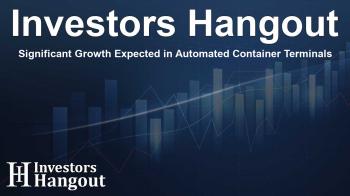Significant Growth Expected in Automated Container Terminals

Automated Container Terminal Market Overview
The Automated Container Terminal market is experiencing significant growth, with projections showing an increase in market size from USD 10.95 Billion to USD 16.35 Billion by 2032. This growth represents a compound annual growth rate (CAGR) of 5.17% from 2025 to 2032, indicating a robust demand for automation in port operations.
Driving Forces Behind Market Expansion
As global trade continues to swell, the need for faster and more efficient port services has become paramount. Innovations in automation and the integration of artificial intelligence (AI) and the Internet of Things (IoT) are pivotal in reducing human error and enhancing operational capabilities within ports.
There is a strong push towards modernizing port infrastructures to accommodate a growing volume of containers, with an emphasis on improving turnaround times. The adoption of automated systems not only enhances safety but also promotes environmental sustainability, as ports seek to comply with more stringent regulations concerning safety and ecological impact.
Investments in Technology
Investing in advanced robotics, IoT technologies, and AI-driven terminal systems is propelling the market forward. The necessity for higher efficiency and cleaner operations is driving ports to automate processes that were traditionally manual.
Market Leaders and Key Players
Several key players are leading the Automated Container Terminal market, with companies like Cargotec Corporation, Konecranes, and Liebherr representing some of the top brands. Each company contributes unique products and innovations, enhancing the capabilities of container terminals worldwide.
Notable advancements include Cargotec's collaboration with Forterra to develop autonomous terminal tractor solutions and Konecranes' recent order for Li-Ion Automated Guided Vehicles (AGVs) aimed at modernizing operations at major terminals.
Segmentation of the Market
The Automated Container Terminal market can be segmented into various categories to better understand its landscape:
By Degree of Automation
Semi-automated container terminals currently dominate the market, capturing approximately 57.23% share as of 2024. These systems are widely utilized in brownfield port operations. Conversely, fully automated container terminals are the fastest-growing segment, achieving a CAGR of 5.45% due to the increasing trend of digitalization in port operations.
By Project Type
Brownfield projects continue to lead the market with around 64.11% share, attributed to ongoing upgrades and expansions in existing port facilities. Greenfield projects are emerging rapidly, with a CAGR of 5.41%, as new terminals are developed to cater to rising trade volumes.
By Offerings and Solutions
Equipment remains the most significant market segment, representing approximately 49.31% of the total share, largely due to high demand for essential terminal infrastructure like cranes and automated vehicles. However, software solutions are gaining momentum, indicated by a CAGR of 5.74%, as ports invest in sophisticated management and monitoring systems.
Regional Insights
Asia-Pacific dominated the Automated Container Terminal market with a substantial share of 39.78% in 2024. This dominance stems from growing international trade and investment in modern terminals. North America is anticipated to see the fastest growth from 2025 to 2032, with a projected CAGR of 5.99% driven by the increasing demand for efficient port operations.
Frequent Innovations in the Industry
The industry is witnessing continuous innovation, with key players actively pursuing advancements. Cargotec’s partnership with Forterra showcases a commitment to developing next-generation automation solutions for terminal operations. Meanwhile, Konecranes' recent orders for advanced AGVs at major terminals exemplify a proactive approach to modernizing the container terminal landscape.
As the industry evolves, the emphasis will remain on enhancing operational efficiency, compliance with environmental standards, and the adaptation of new technologies to improve overall productivity.
Frequently Asked Questions
What is the projected market size for Automated Container Terminals?
The market is expected to grow from USD 10.95 Billion in 2024 to USD 16.35 Billion by 2032.
What factors are driving the growth of this market?
Growth is driven by advancements in automation technology, increasing global trade, and the push for enhanced efficiency and sustainability in ports.
Who are the key players in the Automated Container Terminal market?
Key players include Cargotec Corporation, Konecranes, Liebherr, and ABB among others.
Which regions are leading in the Automated Container Terminal market?
Asia-Pacific leads with a market share of 39.78%, while North America is expected to grow at the fastest rate.
What are the main segments of the Automated Container Terminal market?
Segments include degree of automation, project type, and offerings, which encompass equipment and software solutions.
About The Author
Contact Olivia Taylor privately here. Or send an email with ATTN: Olivia Taylor as the subject to contact@investorshangout.com.
About Investors Hangout
Investors Hangout is a leading online stock forum for financial discussion and learning, offering a wide range of free tools and resources. It draws in traders of all levels, who exchange market knowledge, investigate trading tactics, and keep an eye on industry developments in real time. Featuring financial articles, stock message boards, quotes, charts, company profiles, and live news updates. Through cooperative learning and a wealth of informational resources, it helps users from novices creating their first portfolios to experts honing their techniques. Join Investors Hangout today: https://investorshangout.com/
The content of this article is based on factual, publicly available information and does not represent legal, financial, or investment advice. Investors Hangout does not offer financial advice, and the author is not a licensed financial advisor. Consult a qualified advisor before making any financial or investment decisions based on this article. This article should not be considered advice to purchase, sell, or hold any securities or other investments. If any of the material provided here is inaccurate, please contact us for corrections.

